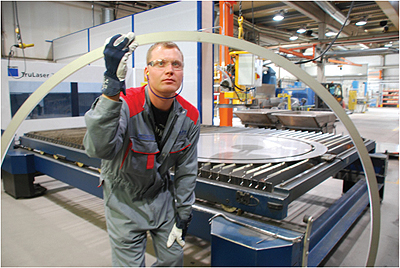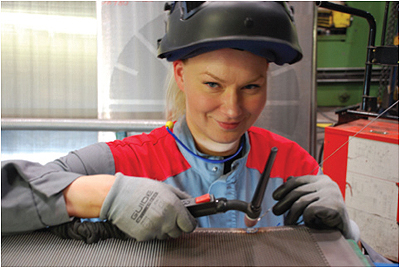AFT
AFT, winning with customers via The Lean ‘Stream’
At the Aikawa Fiber Technologies (AFT) Varkaus, Finland rotor and cylinder plant, everything has been different since 2013, especially the people, who are meeting customer needs like never before
For almost three years running, a new way of working has been in place, referred to as the Lean Stream project. Since then, all business issues – from profitability to sensitive problems – have  become transparent and accessible for the entire team. After just a few years, performance improved steadily. More recently, it has skyrocketed. In fact, AFT’s Lean Stream won recognition in 2014 from Finnish industry as a model, adapting traditional industrial processes to value streams, centred on customers. Continuing improvements are ongoing.
become transparent and accessible for the entire team. After just a few years, performance improved steadily. More recently, it has skyrocketed. In fact, AFT’s Lean Stream won recognition in 2014 from Finnish industry as a model, adapting traditional industrial processes to value streams, centred on customers. Continuing improvements are ongoing.
Why are customers gaining longer life and higher energy savings in pulp and paper mill screening with minimal fiber losses? Why are they consistently getting product exactly when needed? Because work in process and throughput were cut in half, while reliability of supply is consistently above 97 per cent.
According to Antii Kettunen, Plant Manager and Team Leader: “Our gains in efficiency at the Varkaus screen and rotor plant emanate from retooling our thinking around customer satisfaction. Building on Lean management techniques, which originated in Japan, Lean Stream is our invention. We use established continuous improvement methodology, but also unique practices.
“Stream builds around each individual’s ability to visualise all steps of what we do – and the flow and reasons for doing them. Stream employs green lights and strategic parking places to re-define functionality of each process, delivering original equipment and spare parts. We have scorecards visibly posted so that everyone can see how we are doing.”
All hands on deck
Back in 2013 all employees and managers at AFT Varkaus joined together to analyse the entire value chain from sales to delivery. Where is the true value for customers in connection with AFT? Where is the highest value in every aspect of each process?
“Our challenge was to increase the value of know-how, experience, efficiency and services,” says Kari Ikäheimonen, HR Manager at AFT Varkaus: “We had a very capable workforce, a long tradition in manufacturing, a high degree of automation, but fell short. Incremental change was not what the doctor ordered.”
New way of working
Ikäheimonen continues: “We hit on the idea of stream efficiency. We would switch from a resource-based to a production model around customer orders, understanding and modifying the value stream from beginning to end. The magic began to happen when everyone at the factory could see the customer beside him or her at all times. Our reason for being was customers improving their operations.”
Workers now work at their own stations only as long as it takes for the components being manufactured to pass on to the next stage in the process. When there is nothing more to do at their own station, the employee is free to help others with their tasks.
Says Ikäheimonen: “Everyone here uses multiple skills to provide flexibility for customers. We all gain a lot this way in capability and pride.”
“Multiple skills are the key for employees. You don’t stay put any longer,” comments supervisor Kari Ikonen of the Varkaus factory. “It’s a huge change compared with the old system, and it has given new understanding across the entire process. The results speak for themselves.”
Never half, sometimes less
These days, no one leaves half-finished products sitting on the factory floor. That’s the opposite of added value. The objective is always to ensure an uninterrupted and faster flow of products throughout the process. Faster throughput and streamlined production also improves product quality. The lack of stress and removal of all unnecessary materials from the production premises reduces the risk of substandard quality.
“One thing we need to remember is that improvements must be continuous. This revolves around trust between personnel and management. Why distinguish between employees and management when winning ideas are possible, instead of current and sometimes tired practices,” believes Kettunen.
He adds: “Lean Stream thinking helps keep jobs in Finland. AFT’s strengths include the ability to radically challenge traditional thinking, employees committed to continual change and ongoing development of operational processes, staff skills and management systems.”
Embracing customer value as the vital stream of manufacturing
“The Stream project proved to be a turning point. AFT Varkaus achieved remarkable results in terms of overall profitability, reliability of supply and delivery times,” says Risto Weckroth, European Sales Manager.
Comments Kettunen: “Even though the marketplace is better today, internal efficiencies alone would have fallen short of what really mattered. Lean Stream is Value Stream. We shifted from maximum resource efficiency – running expensive machinery at full capacity – to value stream thinking. Truly controlling production does not always mean speed. Sometimes slowing down is better, and that’s why we have ‘parking places.’
“Customer orders are now the official starting point. If an order is due to be delivered at a given time, we now determine when the laser machine and robots should run to ensure that the goods are dispatched to the customer at the right time.
“Lean Stream has worked for every level of worker at every step of the process. That’s why I have my office on the factory floor – to see the stream, and to respond spontaneously to others who see problems and opportunities better than me.”
Orders dictate all, rather than interim stores ruled by machines. If an interim storage slot assigned to the production unit of a given product becomes full, it will not be increased; instead, the operator switches to another machine. As a result, Lean Stream production control has been brought to the shop floor in highly tangible terms.
AFT
Products: Global technology company
